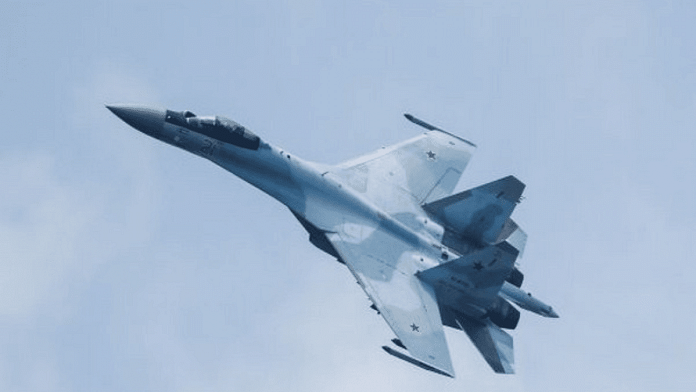New Delhi: In a reflection of the growing military relations between Russia and Iran, defence analysts suggest that the Islamic Republic have received Sukhoi-35 fighters from Russia this week as part of a swap deal involving the Shahed drones.
Since the beginning of the conflict in Ukraine, there has been speculation that Russia signed a deal with Iran to swap Sukhoi-35 fighters for Shahed drones.
The Iranian kamikaze drones were added to Moscow’s arsenal in August last year and deployed on the battlefield with devastating effects by the Russians from September 2022.
The latest reports and videos now suggest that the Kremlin has sent their Sukhoi fighters to Iran on Tuesday, completing the second part of the military deal. Though, an official confirmation of the delivery is awaited.
In March, Iranian state media confirmed that the Islamic republic had finalised a deal to purchase Su-35 aircraft from Russia. As it has an ageing fleet, the Su-35 agreement was significant for sanction-hit Iran’s military.
Suggesting that the Su-35s have reached Iran, defence analysts are circulating videos that show the multi-role fighters purportedly flying near the capital city of Tehran.
Three Su-35 fighter jets have reportedly landed in Iran. Most likely as part of the deal between Russia and Iran where Russia supplies Iran with Su-35 fighters in return for Shahed-136/131 kamikaze drones. pic.twitter.com/vNoIUgaeyv
— NOËL 🇪🇺 🇺🇦 (@NOELreports) April 18, 2023
Russian Su-35s purchased by Iran have begun to arrive at their destination. pic.twitter.com/2r75vyks1n
— Spriter (@Spriter99880) April 18, 2023
Also Read: Why Iran’s drone programme is a ‘triumph’ – Harsh sanctions, western components & simple designs
Mutually beneficial, or economically lopsided swap deal?
While this may represent the swap deal between Russia and Iran coming to fruition, experts are questioning the economic rationale behind the deal. They contend that a simple swap seem “economically lopsided”, as the Su-35 fighter is costlier than the Shahed drone.
But, the deal has clear benefits for both countries that are evident. ThePrint reported Shahed drones have provided “low-cost precision strike capabilities” to the Russian forces on the battlefield. The Russian military has used them to devastating effect to attack military and civilian targets in Ukraine.
The Shaheds are also significant as Russia lacked an alternative to acquiring drones that could counter Ukraine’s adept use of the unmanned aerial vehicles (UAVs) in the early stages of the war.
Essentially, Tehran provided a “stop-gap” solution as “Moscow had been slower to prioritise drone development,” suggests a paper in The Washington Institute for Near-East Policy.
For Iran, acquiring new fighters is significant as it has an ageing fleet marred by sanctions. The Islamic Republic of Iran Air Force (IRIAF) has not acquired a new fighter since the 1990s.
“Iranian Su-35s, even only two dozen of them, would represent a significant leap in Iran’s air combat capability over the ageing and oft-cannibalised American, Chinese, and Soviet-era fighters in its inventory,” online military magazine TheDrive reported.
Essentially, the Su-35s are a developed version of the Su-27 aircraft. The Su-35 is both fast and highly manoeuvrable. It can operate at high altitudes and for long ranges while being equipped with heavy arms. It is often described as a “4++ generation aircraft”, a term used to describe an advanced fourth-generation aircraft.
Egypt-Israel angle
Adding another layer to the delivery of the Su-35s, one analyst states that the aircraft had Egyptian paint as they flew over Iranian airspace.
First delivery of Su-35S from Russia arrived in Iran. The planes still have the Egyptian paint for which they were initially intended.
This is nothing what the Israeli Defense Force cannot handle but it paraphrases that in the Israeli-Iran conflict Russia clearly stands on… pic.twitter.com/fGpGIpZV5V
— (((Tendar))) (@Tendar) April 18, 2023
The German analyst was alluding to the earlier intended sale of the Su-35s to Egyptian Air Force. In late 2018, Russia and Iran had signed the deal and it involved the sale of an estimated 24 Su-35s to Egypt.
Explaining how Western sanctions could prohibit Egypt from receiving the Su-35s, Samuel Ramani, an Associate Fellow at British think tank RUSI said, “If secondary sanctions undermine Egypt’s potential purchase of Su-35 jets from Russia, Iran could be a beneficiary. Iran’s drone provisions for Russia’s war in Ukraine could be linked to the eventual receipt of Su-35s.”
While the Su-35s may provide an essential upgrade to Tehran’s airpower, it will still not entail an effective threat to Israel, a country with whom Iran has had hostile relations.
With the F-35I Adir in its arsenal, Israel was the first country to receive one of the world’s most advanced stealth fighters from its all-weather ally America.
(Edited by Tony Rai)
Also Read: ‘Double agent drone’ — this is how Ukraine is using a Soviet-era weapon to attack Russia






